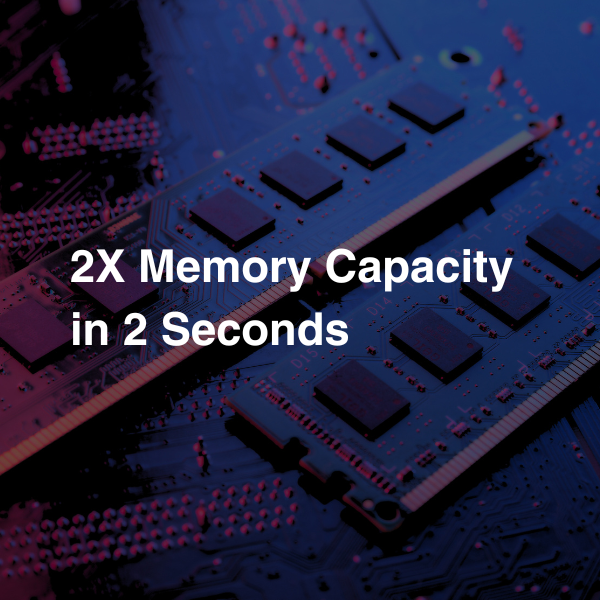Ushering in the Memory Revolution
-1.jpeg?width=2000&height=1132&name=AdobeStock_310584915%20(1)-1.jpeg)
Since the dawn of modern computing, nearly every major subsystem has been reinvented and revolutionized—except memory. Over the past five decades, processors, networks, and storage have undergone dramatic revolutions that reshaped performance, scalability, and economics. Memory, by contrast, has only inched forward, locked in the same fundamental DRAM architecture that debuted in the late 1960s. Let’s take a look back at the major milestones.
Processors: From MHz to Massive Parallelism
The first true computing revolution began with the microprocessor boom of the 1970s. Intel’s 4004 and 8080 chips brought computing to the desktop, while Moore’s Law fueled an exponential rise in transistor density. Through the 1980s and 1990s, we saw the transition from 8-bit to 32-bit and eventually 64-bit architectures, enabling complex operating systems and high-performance computing.
By the 2000s, frequency scaling hit physical limits, giving rise to multi-core CPUs. Companies like Intel and AMD pivoted toward parallelism—packing more cores, threads, and cache per socket. In the 2010s, GPUs, tensor cores, and domain-specific accelerators emerged, revolutionizing compute for AI and simulation workloads.
In short: processor innovation turned linear computing into a massively parallel, power-optimized engine that adapts to workloads in real time.
Networking: From Dial Up to Data Center Fabrics
In the 1960s and 1970s, networking was measured in kilobits. ARPANET’s packet-switching experiments laid the groundwork for today’s Internet. By the 1990s, Ethernet became ubiquitous—scaling from 10 Mbps to 100 Mbps to 1 Gbps. The rise of the World Wide Web and broadband brought global connectivity to homes and enterprises alike.
The 2000s ushered in high-speed backbones, 10G and 40G Ethernet, and the birth of cloud-scale data centers. In the 2010s and 2020s, 400G and 800G optical links redefined data movement, while software-defined networking (SDN) and RDMA over Converged Ethernet (RoCE) eliminated latency barriers inside hyperscale environments.
Networking evolved from static connections into programmable, intelligent fabrics—able to route terabits of data with microsecond precision.
Storage: From Spinning Disks to Solid-State Speeds
Storage has undergone perhaps the most dramatic transformation of all. In the 1970s and 1980s, magnetic hard drives began their dominance—offering mere megabytes of capacity at milliseconds of latency. The 1990s brought RAID arrays, Fibre Channel, and network-attached storage (NAS), decoupling compute from storage and enabling early virtualization.
Then, in the 2000s, the flash revolution began. SSDs displaced HDDs in performance-critical tiers, followed by NVMe in the 2010s, which unleashed orders-of-magnitude lower latency. Today’s data centers leverage tiered storage hierarchies—combining DRAM cache, NVMe, and object storage across local and distributed systems.
Storage evolved from mechanical to solid-state, from monolithic to disaggregated, and from static to software-defined and elastic.

Memory: 50 Years of Incrementalism
Through all these revolutions, memory—specifically, DRAM—has barely changed. Since its invention in 1966, DRAM’s basic design (a single transistor and capacitor per bit) has remained intact. Each generation up to DDR5 brought faster signaling and smaller cells, but not a fundamental shift in architecture or efficiency.
In the 1970s and 1980s, DRAM had been used to drive semiconductor process technology. Throughout the 2000s, however, DRAM has lagged significantly when it comes to logic technology. Moore’s Law has been defunct for a while with respect to DRAM.
The result is a rigid, expensive, and power-hungry memory tier that forces organizations to overprovision to avoid capacity limits. DRAM often represents 50% or more of a server’s cost, yet utilization frequently falls below 50%. Unlike CPUs, storage, and networks, DRAM has no elasticity, no intelligent tiering, and no awareness of application behavior.
The Memory Revolution
MEXT Predictive Memory™ rethinks memory architecture from the ground up. By transforming system flash into a DRAM-speed tier, MEXT creates a transparent memory hierarchy that adapts to workloads—delivering DRAM-class performance with flash-level economics. This allows organizations to:
- Expand usable memory capacity 2–4X without hardware changes
- Reduce overall costs by up to 50%
- Achieve significantly higher performance-per-dollar
- Deploy in under 5 minutes, with zero changes to applications or operating systems
Processors, networking, and storage have all experienced their revolutions. Memory’s revolution has been long overdue. By unlocking a new era of elastic, software-defined memory, MEXT is finally changing that.
Get the Latest
Sign up to receive the latest news about MEXT.
Contact Us
Connect with a MEXT representative or sign up for a free POC.


